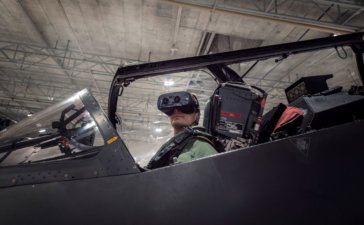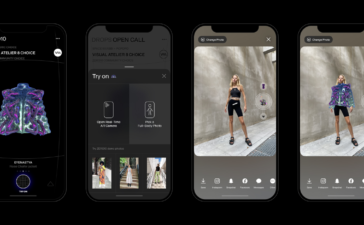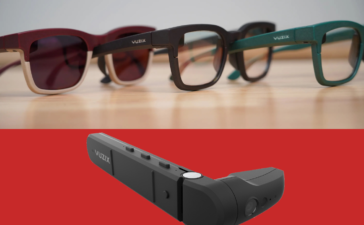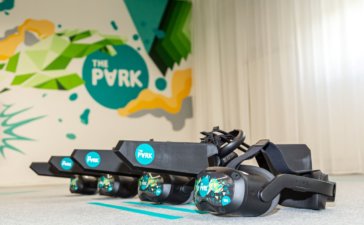Nreal Air is available to US consumers. For those looking for more use cases for the virtual screen display, the company has big news: major console support, and betas for its AR YouTube app and the mac version of its Nebula operating system.
Further, we have a hands-on review from a long-awaited trial of the Nreal Air in action.
The Road So Far
Just two months ago, Nreal Air launched for US consumers. Nreal Air is a lighter-weight model than the Nreal Light, a full-force AR smart glasses product.

This means that Nreal Air has a lot lighter technical demands (it doesn’t require select 5G networks and flagship phones, for example) and is significantly more affordable. It also means that the product had less immediate appeal to consumers hungry for a more robust AR experience, as Nreal Air is primarily a virtual screen solution.
What’s New With Nreal?
Until recently, that meant that Nreal Air was largely a way to screen-mirror an attached phone onto a heads-up display. The device also worked with Steam Deck and Nintendo Switch. This was a boon for users of those devices but it still left other gamers – a major market for this device – out in the rain. Recent announcements change that game.
Nreal for Entertainment
Nreal last week announced support for the latest version of SteamOS, Xbox Series S and X, and the PlayStation 5. For PlayStation 5 users, this means getting your games on the Nreal virtual screen, which is pretty great in itself.

“AR glasses are a fantastic gaming companion, and serving the gaming community is an important strategy for us,” Nreal co-founder Peng Jin, said in a release shared with ARPost. “Users can now connect Nreal glasses to the popular gaming devices to enjoy playing games on a 130” portable HD screen via mirror mode.”
For Xbox and Steam gamers, it means all of this as well as streaming onto the device via cloud services. The announcement also reports that support for GeForce Now, Nvidia’s game streaming service, is coming before the end of the year.
Nreal also announced a beta version of an AR YouTube app. To be clear, YouTube on Nreal was already possible via standard phone mirroring. It was an improvement, but still kind of a letdown because the phone itself had to be used as the input device. The YouTube AR app makes much better use of the Nreal controls. But, more on that in the hands-on section.

“We really appreciate the team at YouTube, who were so supportive of this trial,” Jin said in the release. “This beta is a small step to defining spatial entertainment. We still have a
a lot of ideas to explore in this area, and I hope people will find this first-look experience
entertaining and easy to use.”
Nreal for Work
Last week’s announcement was big for gamers but it wasn’t just for gamers. There’s an important piece in here for desk workers who use Mac.
Nreal is not a super Apple-friendly device. For example, Nreal Air works with iOS, but requires an additional $59 adapter. This extended to functioning with the desktop – which has gaming applications, sure, but could really be big for desk workers using AR for extending their workspace with virtual screens. That’s what makes the Mac Nebula beta so exciting.

“Working within the boundaries of someone else’s technologies is not easy. This release is meant to give people a preview of what is possible. We want to bring everyday AR experiences to the mass consumer market, so we’re excited to offer this solution for Mac users,” said Jin.
A Hands-On Review of Nreal Air
Nreal put a pair of the $379 Nreal Air in my hands. I got a sneak peek of Nreal Air at an expo before their consumer release, but it was just a look-see. This time I got to spend some meaningful time with the product in my own home entirely unsupervised. These are my honest thoughts on the device.
Device Setup and First-Day Jitters
The setup for the device was pretty simple. At least, significantly less complicated than the initial setup for a device like the Quest 2 (review). It also helps that the Quest app is a companion app for the headset, while the phone is a companion device for the Nreal Air so doing things like confirming my email address went a lot more smoothly.
I had some hiccups on the first day, when the display on the glasses would freeze and sputter, and I would have to reconnect it. However, this seems to have been a one-time thing that only happened the first day that I was using the device.
Most of the setup was software, but there are one or two points on the headset itself that you can tweak as well. For example, buttons on the arms control the brightness of the display. The arms can also be manually adjusted up and down. This is huge because the display itself is at an angle to your eye, so adjusting the arms can really improve the comfort of the experience.
While we’re talking about things like display and comfort, the glasses beyond the display are tinted like sunglasses. This reduces “eye glow” as perceived by others, but it also means that the glasses work really well in bright conditions as well. Incidentally, your eye can also focus past the display to see what’s going on in your environment behind your virtual screen.
Screen-Mirroring and Apps
As mentioned above, the screen mirroring works just fine but it maintains the phone as the input device. So, if you’re doing things that require a lot of activity on your part, you’re usually looking at the phone anyway. So this feature is handy for, say, navigating to a video file and then watching it, but isn’t necessarily a huge improvement for things like email.
Further, I found reading the fine print in the glasses a little trying. For example, scrolling through YouTube I could read video titles just fine but reading the smaller description text was more challenging. To be fair, I didn’t notice that problem trying out the Lenovo ThinkReality A3, but – despite a similar form factor – that’s an enterprise device that costs a thousand dollars more than the Nreal Air.

Using the actual AR mode is a different story. The phone is still the input device, but in its touchscreen capacity. The phone casts a ray into your view on the glasses and then tapping the screen makes selections. Scrolling on the touch screen of the phone also scrolls through menus etc., and pinching the device controls the location and zoom level of your virtual screens.
Returning again to YouTube but this time in the beta app, I found the controls much more organic, but I was also able to blow up the screen such that I had a much easier time with that small type. At this point, I pulled up a Looney Tunes short and handed the glasses to my brother so that I could see what they look like in action.
From the Outside Looking In
When the glasses are in use, reflections within the glasses are virtually non-existent. Looking at the glasses as my brother wore them, I would have been hard-pressed to tell whether the light in the lenses was from the glasses operating or just reflections from the environment. In any case, I couldn’t tell by looking at the glasses from the outside what was playing within.
The audio was a similar case. Nreal Air has onboard speakers in the arms. The audio quality is really good, and I assumed that the volume would be pretty noticeable for others as well, but this isn’t the case. As with the “eye glow,” I could tell that the glasses were making noise while he was wearing them, but I couldn’t make it out. The speakers are effective and discrete.
I also noticed that, while the lack of gesture controls was admittedly a bit of a put-down for me, using the phone as the input is also very discrete. Instead of looking like one is swatting imaginary flies to navigate menus, it’s a subtle tap of the screen – maybe a slight movement of the phone itself. Someone in, say, an airport with the device would blend right in.
For all of my input, my brother’s was perhaps the more impactful. He’s a more avid console gamer than me but has far less exposure to XR. After about 20 seconds of watching Looney Tunes on Nreal Air’s virtual screen he asked me, “So, we basically don’t need TVs anymore?”
Virtual Screens for the Win
There are times when you’ll still want a computer to do your work. There are times when you’ll still want a TV to play games or watch movies. But AR glasses and virtual screens are increasingly gaining ground. I’m glad that I’m typing this on a laptop. But, watching a video on my phone screen felt kind of silly after using Nreal Air. And it’s only coming to more devices.



























